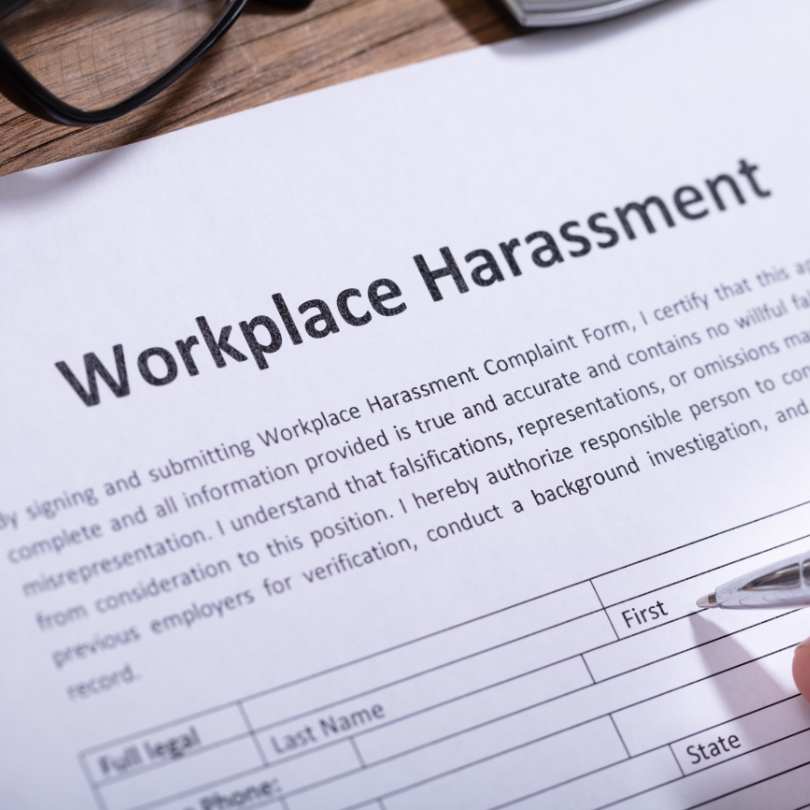Workplace abuse is a prevalent and damaging issue that can have severe consequences for both employees and organizations. Recognizing, addressing, and preventing such abuse is crucial for creating a healthy and productive work environment. In this article, we’ll delve into workplace abuse types, their effects on staff and firms, legal safeguards, and reporting steps. We’ll discuss seeking support after facing workplace abuse and how organizations can proactively prevent it.
Key Takeaways
Understand workplace abuse and its consequences to employees & organizations.
Recognize the red flags of victims & abusers, as well as legal protections against workplace abuse.
Seek support when dealing with it, and prevent future occurrences through anti-harassment policies, training & education.
Understanding Workplace Abuse

Workplace abuse can take many forms, ranging from offensive jokes, slurs, and put-downs to physical assaults or threats, intimidation, and interference with work performance. When offensive behavior becomes a job necessity and creates a hostile environment, it’s deemed unlawful. Employers, in fact, are accountable when supervisor harassment results in job losses, missed promotions, or reduced wages.
The effects of workplace abuse can be devastating for both employees and organizations. Some of the negative consequences include:
Decreased morale
Increased absenteeism
Lower productivity
Higher turnover
Moreover, victims may need to consult with their legal team, which may include labor lawyers or labor attorneys, to address the issue of overtime pay, especially when dealing with independent contractors or labor unions, and to assess the possibility of a wrongful termination lawsuit.
We will delve into the different types of workplace abuse and their impact on employees and organizations to gain more insight into the issue.
Types of Workplace Abuse
Workplace abuse is any mistreatment that occurs in the workplace, such as:
Harassment
Discrimination
Bullying
Violence
When offensive conduct becomes a requirement for continued employment or creates an intimidating, hostile, or abusive work environment, it is considered unlawful. Recognizing and addressing workplace abuse requires a grasp of its various forms, from persistent criticism to threats, humiliation, and sabotage.
Examples of workplace abuse include:
Wrongful termination
Employment discrimination based on race, color, religion, national origin, sex, and other protected characteristics
Harassment
Retaliation
Employees and organizations can more effectively identify and address these different types of abuse with increased awareness.
Effects on Employees and Organizations
Workplace abuse can have wide-ranging consequences for employees and organizations. Some of the effects on employees include:
Decreased job performance
Increased absenteeism
Difficulty concentrating
Low work efficiency and quality
Moreover, workplace abuse can have severe effects on employees’ mental well-being, which further impacts their productivity.
For organizations, workplace abuse can lead to financial losses due to decreased productivity, high turnover rates, and legal and litigation costs. In particular, workplace bullying and violence are especially damaging to employee retention and may lead to wrongful termination.
To ensure a safe, supportive work setting, employees and organizations must understand and address workplace abuse effects.
Recognizing the Signs of Workplace Abuse

Both victims and bystanders need to be adept at recognizing the signs of workplace abuse. Recognizing issues like verbal criticism, threats, harassment, or abuse allows individuals to effectively address and combat them.
Awareness is key, as persistent mistreatment can affect one’s well-being and may even escalate. Familiarity with the various warning signs and red flags of workplace abuse allows individuals to more accurately identify when they or someone they know may be experiencing abuse. This can empower them to take appropriate action, seek support, and ultimately put an end to the abuse.
Red Flags for Victims
Victims of workplace abuse may exhibit signs such as withdrawal and isolation, heightened anxiety and stress, lower self-esteem and confidence, changes in behavior and performance, and physical symptoms like headaches and fatigue. Facing workplace abuse, one might feel anxiety, depression, and low self-esteem, leading to doubts about job competence. Appropriate steps to address workplace abuse must be taken when these signs are experienced.
Additionally, victims may experience:
Repeated mistreatment
Verbal criticism
Threats
Humiliation
Intimidation
Undermining of their work
Victims must recognize these red flags to take action, seek support, and ultimately put an end to the abuse.
Red Flags for Abusers
Abusers in the workplace can exhibit a variety of warning signs, such as:
Verbal abuse, threats, intimidation, ridicule, and humiliation
Social isolation and sabotage
Narcissism, difficulty regulating themselves, lack of remorse, and lack of conscience
A history of violent acts or abusive behavior
Aggression and anger towards employees
Purposefully causing conflict and creating a hostile work environment
Abusers may use various tactics to exert control over their victims, including:
Manipulation
Gaslighting
Isolation
Over-protection
Overpowering their victims’ views and opinions
To create a safer and more supportive work environment for everyone, it is vital to recognize these red flags and take action to identify and address abusers in the workplace.
Legal Protections Against Workplace Abuse

There are various legal protections in place to address workplace abuse, both at the federal and state levels. These laws aim to prevent workplace harassment and discrimination based on certain characteristics, ensuring that employees have the right to a safe and supportive work environment. Familiarity with the available legal protections is essential for understanding one’s rights and the steps that can be taken in response to workplace abuse. It’s always recommended to consult with an expert labor attorney. This ensures you address this serious issue in the most effective way to achieve the outcome you deserve.
We will examine the different federal and state laws that protect employees from workplace abuse, and the agencies responsible for handling abuse complaints. Understanding these legal protections can help individuals navigate the process of addressing workplace abuse and seeking justice.
Federal Laws
Several federal laws provide protection against workplace abuse, including Title VII of the Civil Rights Act of 1964, the Americans with Disabilities Act (ADA), the Age Discrimination in Employment Act (ADEA), and the Equal Pay Act of 1963. These laws prohibit employment discrimination based on race, color, religion, sex, national origin, disability, and age. They also provide protection against harassment and hostile work environments.
Employees and organizations can more effectively address workplace abuse and discrimination and foster a healthier, more inclusive work environment by understanding and utilizing employment law. These federal laws serve as a foundation for addressing workplace abuse at the federal level, but it is also essential to be familiar with state laws that may offer additional protections.
State Laws
State laws regarding workplace abuse can vary significantly, with some states offering more comprehensive protections than others. For example, California, Connecticut, Illinois, Maryland, Minnesota, New Jersey, Oregon, and Washington require employers to have workplace violence prevention programs, while New York mandates employers to provide anti-harassment training.
It’s important to check the laws of your state to know what kind of protection is offered. Employees and organizations must understand the differences in state laws to ensure compliance with their state’s regulations and to provide a safe and supportive work environment.
In some cases, state laws may offer additional protections beyond those provided at the federal level, making it essential to be familiar with both federal and state laws when addressing workplace abuse.
How to Report Workplace Abuse

Reporting workplace abuse is a critical step in addressing the issue and seeking justice for the victim. There are various avenues available for reporting abuse, both internally within an organization and externally to government agencies. Understanding the different reporting options and the steps involved in each process can help individuals navigate the complex process of addressing workplace abuse.
We will guide you on how to report workplace abuse within an organization and how to file a complaint with an external agency. Knowing how to report abuse is essential for taking appropriate action and finding the support and resources needed to address the issue.
Internal Reporting
When reporting workplace abuse internally, victims can speak with their supervisor or human resources department, or follow company procedures for filing a complaint. Internal reporting can provide a confidential avenue for addressing the issue and resolving it within the organization. However, it is essential to be aware of the potential drawbacks of internal reporting, such as fear of retaliation, lack of impartiality, inadequate resolution, and limited assistance.
Understanding the organization’s policies and procedures for handling complaints is crucial before reporting workplace abuse internally. This can help ensure that the issue is addressed appropriately and that the victim receives the support they need throughout the process.
External Reporting
External reporting of workplace abuse typically involves filing a complaint with a government agency, such as the Equal Employment Opportunity Commission (EEOC) or a state agency. This process can provide additional resources and support beyond what may be available within the organization, and in some cases, may be necessary for legal action to be taken.
When filing a complaint with the EEOC, individuals will need to provide various information, such as:
Contact information
Description of the discrimination or harassment
Any supporting documents or evidence
Names and contact information of any witnesses
Awareness of the time limits for filing a complaint is essential, and the report must be made within 180 days of the discrimination occurring.
Seeking Support During and After Workplace Abuse

Seeking support during and after experiencing workplace abuse is crucial for emotional well-being and recovery. Various resources, such as online support groups and mental health professionals, can provide assistance, understanding, and coping strategies for those affected by workplace abuse. Utilizing these resources can help individuals heal and regain their confidence in the workplace.
We will examine the different support options for individuals who have experienced workplace abuse, including online support groups and mental health professionals. By understanding the support available, individuals can find the resources they need to address the emotional impact of workplace abuse and move forward.
Online Support Groups

Online support groups offer a safe and secure environment for individuals who have experienced workplace abuse to share their experiences and connect with others who may be going through the same thing. These support groups provide a valuable resource for individuals seeking understanding, empathy, and support from others who have faced similar challenges in a support group setting.
Various online support groups are available here, check and book a session, it’s totally free of charges. Individuals can find a supportive community of peers offering guidance, encouragement, and understanding throughout their healing process by joining these online communities.
Mental Health Professionals
Mental health professionals can provide valuable guidance, coping strategies, and treatment for individuals who have experienced workplace abuse. By addressing the emotional and psychological toll of the violence, mistreatment, mental health professionals can help victims learn how to cope, build back their self-esteem, and manage any stress and anxiety that may have resulted from the abuse.
Mental health professionals, such as psychologists and counselors, can be found here. Working with these professionals can provide individuals with the support and assistance needed to heal and recover from the effects of workplace abuse.
Preventing Workplace Abuse

Preventing workplace abuse is an essential responsibility for organizations and employees alike. By implementing anti-harassment policies and offering training, organizations can proactively promote a safer work environment.
We will discuss the implementation of proactive measures to prevent workplace abuse, including the development of anti-harassment policies and provision of training and education programs. By understanding these prevention strategies, organizations can create a safe and supportive work environment for all employees.
Developing an Anti-Harassment Policy
Developing an effective anti-harassment policy is a crucial step in preventing workplace abuse. A sound policy should clearly define behavior expectations, detail consequences for violations, and offer a structure to handle abuse incidents.
Key elements of a successful anti-harassment policy include:
Clear complaint procedures
Making supervisors responsible for addressing complaints
Creating a safe work environment
Providing training on unconscious bias
Fostering open communication
Taking immediate action on complaints
Organizations can ensure employees understand their expectations and the consequences of engaging in abusive behavior by implementing a comprehensive anti-harassment policy.
Training and Education
Training and education programs can play a vital role in preventing workplace abuse by teaching employees how to recognize and report abusive behavior and fostering a respectful work environment. Examples of such programs include violence prevention training, workplace bullying and violence prevention training, and healthcare violence prevention training.
Regular training and education can deepen employees’ understanding of harassment, bullying, and discrimination, leading to a more respectful work environment. In addition, management should play an active role in providing training and creating a comprehensive workplace violence prevention program to ensure everyone is safe while at work.
Summary
In conclusion, recognizing, addressing, and preventing workplace abuse is essential for creating a healthy, productive, and supportive work environment. By understanding the various forms of abuse, their impact on employees and organizations, and the legal protections available, individuals can take appropriate action to address workplace abuse. For emotional well-being and recovery, it’s vital to seek support during and after facing abuse. Additionally, organizations should proactively work to prevent such abuse from happening initially. Together, we can create a safer and more inclusive workplace for everyone.
Frequently Asked Questions
What defines abuse in the workplace?
In the workplace, abuse can manifest as shouting, demeaning comments, or even bullying, leading to emotional or physical harm. It can range from threats and verbal abuse to physical assaults and even homicide.
What are signs of abuse in the workplace?
Signs of abuse in the workplace can include berating people, coercing them to do things they don’t want to, dismissing their efforts, embarrassing them in public, excluding others, intimidating people, lying, making snide remarks, micromanaging and monitoring work, setting unreasonable expectations, changing expectations and guidelines often, having mood swings, excessively criticizing work or behavior, withholding information, stealing credit for work, making frequent threats, constantly interrupting, humiliating others, nitpicking their actions, acting like your friend, demanding after hours work, or engaging in sexual harassment.
What are the 4 types of workplace violence?
Workplace violence is classified into four categories: criminal intent, customer/client, worker-on-worker, and personal relationship. These four types are recognized by the National Institute of Occupational Safety and Health (NIOSH).
What is the meaning behind you are not alone?
“You’re not alone” is a comforting phrase said by a companion to someone in distress, meaning that they are always there for them.
What legal protections are available against workplace abuse?
In US Employees are legally protected from workplace abuse through federal and state laws such as Title VII of the Civil Rights Act and the Americans with Disabilities Act.
If you’re experiencing workplace mistreatment, it’s essential to seek expert guidance. We strongly recommend turning to our professionals, easily accessible on the Assistance HUB page, to navigate these challenges and ensure your well-being.

